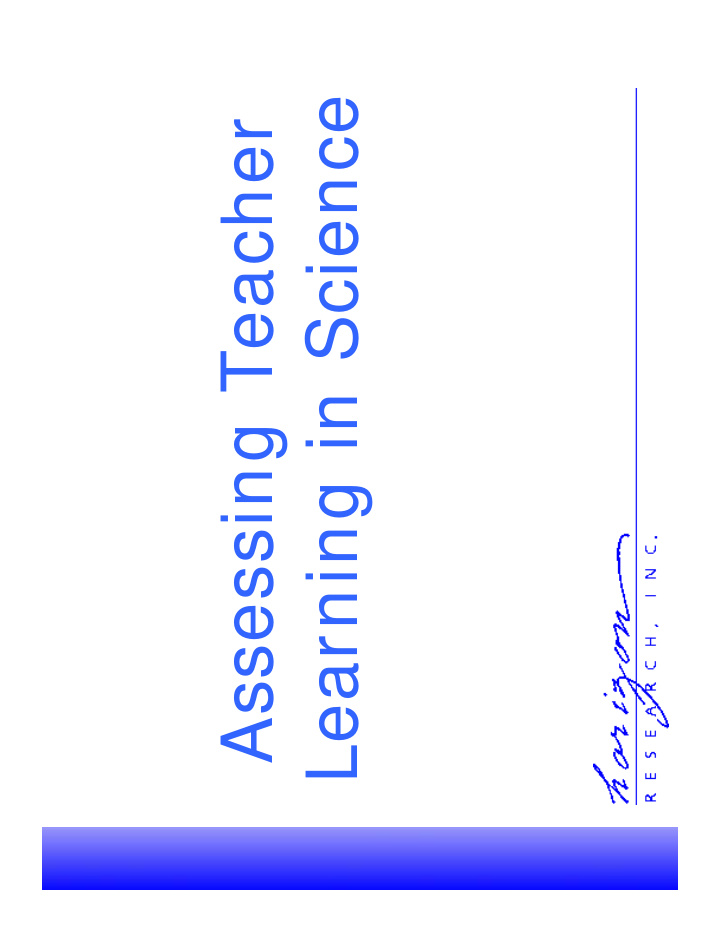



Assessing Teacher Learning in Science
Session Goals • Discuss the various dimensions of teacher knowledge. • Be aware of some issues related to assessing teacher learning. • Become familiar with the development work of ATLAST.
Session Overview • ATLAST project overview. • Dimensions of teacher knowledge. • Issues related to developing/ using items and instruments. • Wrap up.
Assumptions • Primary interest is for evaluation purposes. • MSPs are constrained to approaches that are not labor-intensive.
knowledge does an item tap? What dimensions of
ATLAST Overview
Implicit Theory of Action Improved Increased Increased Teacher Professional K-12 Student Classroom Knowledge for Development Practice in Achievement Teaching Science Science in Science Science Curriculum Materials
Goals of ATLAST • Create and validate instruments to measure each component of the theory • Codify procedures for creating instruments • Provide T.A. to MSPs on using the instruments • Disseminate instruments, procedures, and lessons learned
Content Areas • Force and motion • Processes that shape Earth • Flow of matter and energy in living systems
Force and Motion Benchmark An unbalanced force acting on an object changes its speed or direction of motion, or both. If the force acts toward a single center, the object's path may curve into an orbit around the center.
Instruments • Student science content knowledge assessment • Student opportunity to learn (SOTL) instruments – Curriculum materials analysis – Classroom observation protocol – Teacher interview protocols – Teacher instructional log • Teacher knowledge for teaching science assessment • Teacher opportunity to learn (TOTL) instruments
Development of Teacher Assessments 1. Clarify the benchmark. 2. Identify student and teacher thinking about the benchmark. 3. Write open-ended items for teachers. 4. Write multiple choice items for teachers. 5. Pilot and field test items. 6. Create scales.
Sample open-ended item You decide to take your 8 th grade class to the bowling alley for some “hands-on” experience with force and motion. You ask Jill to take a turn. After she releases the ball, you ask her to describe the horizontal force(s) that are acting on the ball as it rolls down the lane. Jill describes two forces: 1) the force of the ball moving forward down the lane, and 2) the force of friction that slows the ball down. What aspects of her response, if any, are correct? What aspects of her response, if any, are incorrect?
Dimensions of Teacher Knowledge for Teaching Science 1. disciplinary content 2. alternative frameworks for thinking about the content 3. relationships between big ideas and the supporting ideas 4. student thinking about the content 5. strategies to diagnose the thinking of a particular group of students 6. how to sequence ideas for students 7. content-specific strategies that move students’ thinking forward
Revised Dimensions 1. disciplinary content 2. alternative frameworks for thinking about the content 3. relationships between big ideas and the supporting ideas 4. student thinking about the content 5. strategies to diagnose the thinking of a particular group of students 6. how to sequence ideas for students 7. content-specific strategies that move students’ thinking forward
Dimension Resources 1. disciplinary content 2. alternative frameworks for thinking about the content 3. relationships between big ideas and the supporting ideas 4. student thinking about the content 5. strategies to diagnose the thinking of a particular group of students 6. how to sequence ideas for students 7. content-specific strategies that move students’ thinking forward
Instrument Availability • Force and Motion—Spring 2005 • Forces that shape Earth—Spring 2006 • Flow of matter and energy in living systems—Spring 2006
ATLAST Assessing Teacher Learning About Science Teaching Sean Smith, PI Horizon Research, Inc. 326 Cloister Court Chapel Hill, NC 27514 ssmith@horizon-research.com 919-489-1725
Recommend
More recommend